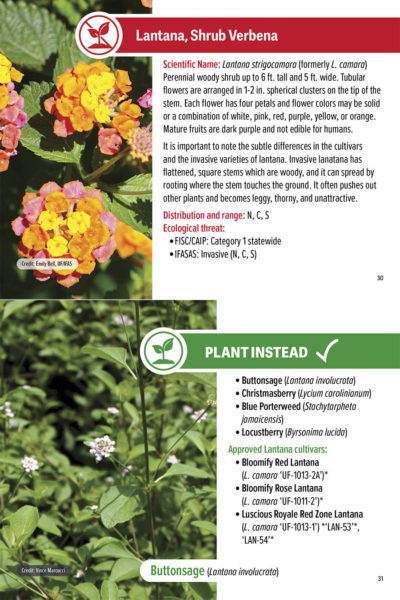Florida’s climate makes a cozy environment for a variety of plant species. The downside is that invasive and potentially destructive species often try to call Florida home, too. A new guide developed by UF/IFAS Extension Seminole County outlines which plants to avoid and which plants to embrace in a Florida landscape.
The annual impact of invasive plants, animals and disease to Florida’s agriculture industry is estimated at $179 million. To prevent contributing to the greater problem, homeowners, landscapers, small-scale nurseries and plant lovers should carefully select plants they purchase and install.

“Invasive plants are never the right plants,” said Tina McIntyre, UF/IFAS Extension Seminole County Florida-Friendly Landscaping agent. “Ornamental plants sometimes become invasive species in our natural lands and waterways. I spent the first 10 years of my career in the field as a biologist and frequently saw this happen. Now, I educate homeowners, landscape professionals and the public about ways they can make a difference. This guide is one of those tools.”
The small, portable guide is designed for on-the-go use in the field for professionals and homeowners.
“We receive so many questions from homeowners and landscapers about invasive species terminology, why they matter and how they could help,” said McIntyre. “I needed a comprehensive resource for them so they could better understand that plant selection is really an issue of right plant, right place.”
Some plants are invasive and their sale in Florida is prohibited. However, many plants in Florida are invasive and still permitted for sale.
“We want people to think more critically about the plants they select for their landscapes,” said Morgan Pinkerton, UF/IFAS Extension Seminole County agent in sustainable agriculture and food systems. “It is up to all of us to make more sustainable choices in the landscape, especially our professionals. Their choices can make impacts on an even larger scale. Avoiding invasive species, even those often still for sale, is an important step when we talk about long term sustainability of our environment.”
The guide is available for purchase at the UF/IFAS Extension Bookstore. For more information on purchasing native plants, visit the Florida Association of Native Nurseries website. A list of native and Florida-Friendly plants can be found on Ask IFAS.
“We want consumers to avoid plants that can be costly burdens to our economy, environment and society,” said McIntyre. “This book is a great tool for educators and others to be sure they pick plants for their landscape that are beneficial to the world around them.”
Partners of this project include funding from Seminole County Leisure Services, contributions from Rachel Gutner and Sandy Wilson and review by Central Florida CISMA and Deah Lieurance.

